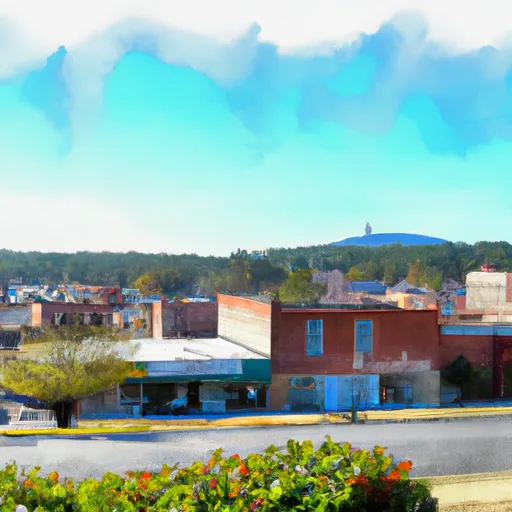-
 Snoflo Premium
Snoflo Premium
Get unlimited access to all our content
With no Ad interruptions! - Start Your Free Trial Login with existing account
Juniper
Eden Index
Climate
8.0
•
Recreation
•
Community
•
Safeguard
3.2/10

Juniper, Georgia is a charming town located in the southern part of the state. Known for its pleasant climate and picturesque landscapes, Juniper offers a delightful experience for both residents and visitors alike.
The climate in Juniper is typically warm and humid, with hot summers and mild winters. Summers are perfect for outdoor activities, with temperatures ranging from the mid-80s to low 90s Fahrenheit. Winters are relatively mild, with temperatures averaging in the mid-50s. The area receives a moderate amount of rainfall throughout the year, contributing to the lush greenery that surrounds the town.
The hydrology constituents of Juniper are primarily influenced by the nearby river and streams. The town is situated near the Juniper River, which provides an abundant water source for recreational activities such as fishing, boating, and swimming. The river also supports a diverse ecosystem, making it an ideal destination for nature enthusiasts.
Outdoor recreation opportunities in Juniper are plentiful. The town boasts several parks and trails, offering opportunities for hiking, biking, and picnicking. Additionally, the nearby mountains provide excellent terrain for camping and wildlife observation. Juniper is also home to a golf course, allowing enthusiasts to enjoy a round of golf amidst the beautiful scenery.
Overall, Juniper, Georgia offers a pleasant climate, abundant water sources, and diverse outdoor recreation opportunities, making it an enticing destination for those seeking an active and nature-filled lifestyle.
What is the Eden Index?
The Snoflo Eden Index serves as a comprehensive rating system for regions, evaluating their desirability through a holistic assessment of climate health, outdoor recreation opportunities, and natural disaster risk, acknowledging the profound impact of these factors on livability and well-being.
Climate Health Indicator (CHI): 8.0
Juniper receives approximately
1239mm of rain per year,
with humidity levels near 85%
and air temperatures averaging around
18°C.
Juniper has a plant hardyness factor of
8, meaning
plants and agriculture in this region tend to thrive here all year round.
By considering the ideal temperature range, reliable water supplies, clean air, and stable seasonal rain or snowpacks, the Climate Health Indicator (CHI) underscores the significance of a healthy climate as the foundation for quality living.
A healthy climate is paramount for ensuring a high quality of life and livability in a region, fostering both physical well-being and environmental harmony. This can be characterized by ideal temperatures, reliable access to water supplies, clean air, and consistent seasonal rain or snowpacks.
Weather Forecast
Streamflow Conditions
Apalachicola
Area Rivers
Apalachicola
Snowpack Depths
Apalachicola
Reservoir Storage Capacity
Apalachicola
Groundwater Levels
Recreational Opportunity Index (ROI):
The Recreational Opportunity Index (ROI) recognizes the value of outdoor recreational options, such as parks, hiking trails, camping sites, and fishing spots, while acknowledging that climate plays a pivotal role in ensuring the comfort and consistency of these experiences.
Access to outdoor recreational opportunities, encompassing activities such as parks, hiking, camping, and fishing, is crucial for overall well-being, and the climate plays a pivotal role in enabling and enhancing these experiences, ensuring that individuals can engage in nature-based activities comfortably and consistently.
Camping Areas
| Campground | Campsites | Reservations | Toilets | Showers | Elevation |
|---|---|---|---|---|---|
| Williams Landing | None | 80 ft | |||
| McKinney - Allatoona Lake | None | 889 ft | |||
| Cochran Mill County Park | None | 937 ft | |||
| Clark Creek South - Allatoona Lake | None | 858 ft | |||
| Coe Landing | None | 85 ft | |||
| F.D. Roosevelt State Park | None | 1,272 ft | |||
| Hall Landing | None | 93 ft | |||
| High Bluff Landing - Lake Talquin State Forest | 34 | 91 ft | |||
| Clark Creek North - Allatoona Lake | None | 896 ft | |||
| Dobbins Lakeside Military | None | 1,079 ft |
Nearby Ski Areas
Catastrophe Safeguard Index (CSI):
The Catastrophe Safeguard Index (CSI) recognizes that natural disaster risk, encompassing floods, fires, hurricanes, and tornadoes, can drastically affect safety and the overall appeal of an area.
The level of natural disaster risk in a region significantly affects safety and the overall livability, with climate change amplifying these risks by potentially increasing the frequency and intensity of events like floods, fires, hurricanes, and tornadoes, thereby posing substantial challenges to community resilience and well-being.
Community Resilience Indicator (CRI):
The Community Resilience Indicator (CRI) recognizes that education, healthcare, and socioeconomics are crucial to the well-being of a region. The CRI acknowledges the profound impact of these elements on residents' overall quality of life. By evaluating educational resources, healthcare accessibility, and economic inclusivity, the index captures the essential aspects that contribute to a thriving community, fostering resident satisfaction, equity, and social cohesion.

